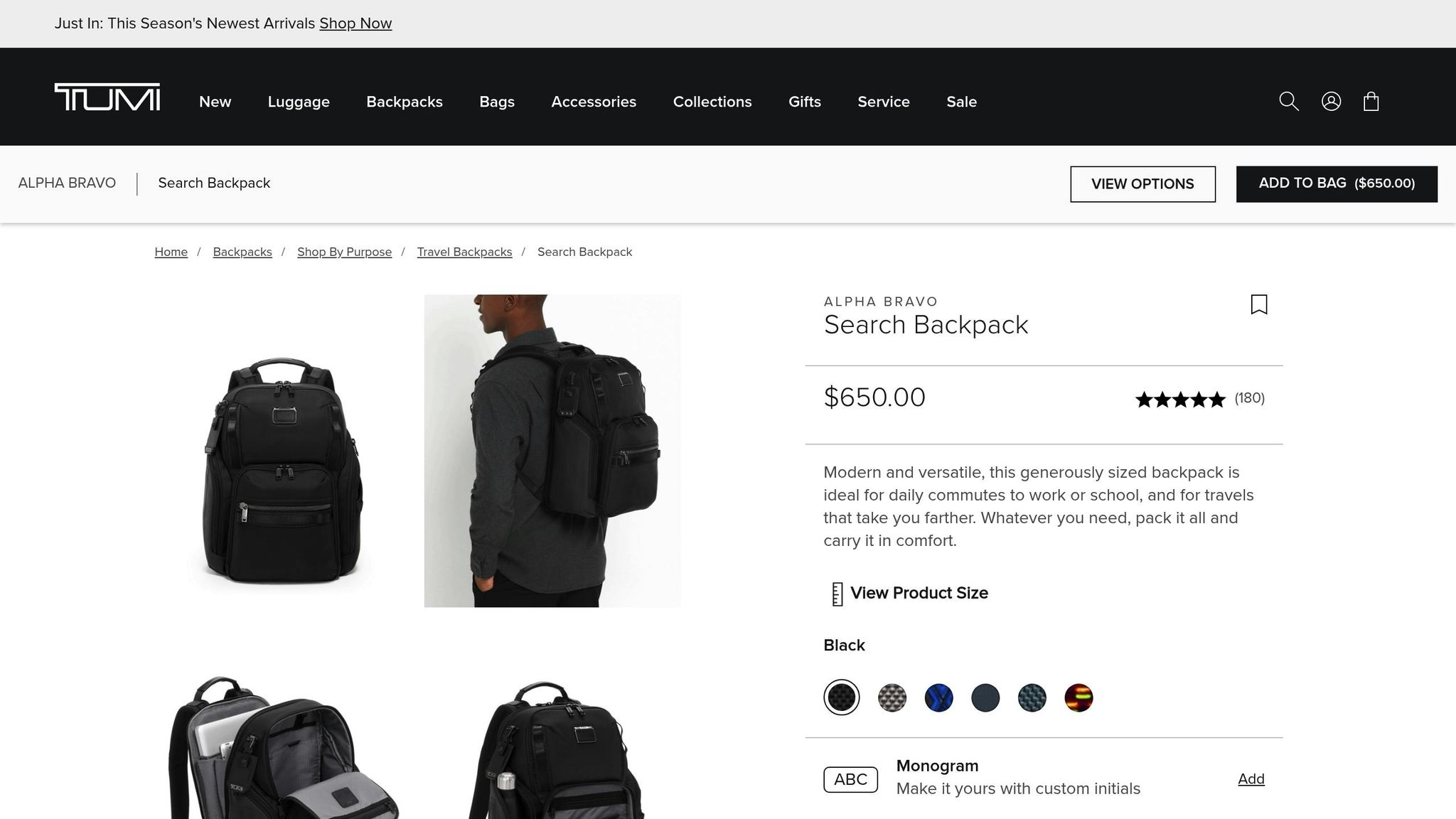Ballistic nylon is the top choice for business backpacks due to its durability, water resistance, and professional appearance. Originally developed for military use, it’s now a leading material for professionals needing a tough, low-maintenance option for daily commutes and business travel. Here’s why ballistic nylon stands out:
- Durability: High-denier nylon (840D–1680D) with a 2×2 basket weave resists abrasions, tears, and punctures.
- Water Resistance: Naturally repels light rain; coatings like PU or DWR enhance protection.
- Weight: Strong yet lightweight, ideal for carrying laptops and essentials without added bulk.
- Professional Look: Sleek texture and matte finish suit workplace settings.
- Low Maintenance: Easy to clean with a damp cloth and mild soap.
Alternatives like PU leather and canvas have their own pros and cons:
- PU Leather: Affordable and stylish but less durable and prone to cracking.
- Canvas: Eco-friendly and sturdy but heavier and less water-resistant.
Quick Comparison
| Material | Durability | Water Resistance | Weight | Appearance | Maintenance |
|---|---|---|---|---|---|
| Ballistic Nylon | Excellent (5–10 years) | High (with coatings) | Lightweight | Professional, modern | Easy |
| PU Leather | Moderate (3–5 years) | Moderate (not waterproof) | Lightweight | Leather-like, stylish | Requires care to avoid cracking |
| Canvas | Good (varies) | Low (needs treatment) | Heavier | Casual, relaxed | Requires regular cleaning and treatment |
Conclusion: Ballistic nylon is ideal for professionals prioritizing durability, practicality, and a polished appearance. It balances performance and affordability, making it a reliable investment for long-term use.
Tumi Alpha Bravo Search Backpack (Ballistic Nylon) – 90 Days Usage, Review And Functionality.

1. Ballistic Nylon
Ballistic nylon stands out as a top choice for business backpacks due to its combination of strength, practicality, and style. It’s an excellent option for professionals navigating daily commutes, business trips, or office routines.
Durability
Built with a tight 2×2 basket weave and high-denier fibers (ranging from 840D to 1,680D), ballistic nylon offers outstanding resistance to tears and punctures. This durability ensures that your backpack can handle the wear and tear of everyday use while keeping its compartments intact.
Water Resistance
Ballistic nylon doesn’t just hold up against physical damage – it also provides a solid defense against weather. It naturally repels light rain and minor spills, and when paired with coatings like PU or DWR, its water resistance improves even further. This makes it a reliable choice for unpredictable conditions.
Weight
One of the standout features of ballistic nylon is how it balances strength with a lightweight design. The high-strength fibers allow manufacturers to craft backpacks that are protective yet easy to carry. This is particularly important for professionals who need to transport laptops, documents, and other essentials without feeling weighed down.
Professional Appearance
Beyond its practical benefits, ballistic nylon has a polished, professional look that fits seamlessly into workplace settings. Its basket-weave texture and matte finish create a sleek and modern aesthetic that maintains its appeal over time.
"Despite its rugged nature, ballistic nylon has a sleek and modern aesthetic." – The Man Bag Co
Maintenance
Keeping ballistic nylon clean is a breeze. All it takes is a damp cloth or a bit of mild soap and water to remove dirt, and it dries quickly without compromising its protective coatings. This low-maintenance quality makes it even more appealing for busy professionals.
2. PU Leather
PU leather has its perks, but when it comes to durability, it doesn’t quite match up to ballistic nylon. Knowing its strengths and weaknesses can help professionals make smarter choices when investing in business bags. Let’s break down its key performance features, starting with durability.
Durability
Compared to ballistic nylon, PU leather is more prone to scratches and general wear. On average, it lasts about 3–5 years, which might not be ideal for those who need a bag to endure heavy, daily use. High-stress areas like zippers, handles, and corners are especially vulnerable, often showing signs of wear much faster. This can be a drawback for professionals who depend on their backpacks day in and day out.
Water Resistance
PU leather does provide some water resistance, thanks to its polyurethane coating, but it’s far from being completely waterproof. It can handle light moisture or small spills, making it suitable for brief exposure to water. However, extended contact with water can lead to peeling or degradation. As Leder Teknix, a Leather Technologist, explains, "PU Leather is not water proof, it is Water Resistant due to the top Polyurethane coating…it can easily be cleaned with a damp cloth". For professionals, this means PU leather backpacks can handle a quick dash through the rain or an accidental spill, but they’re not built for prolonged outdoor use. To keep the material in good shape, it’s important to wipe off moisture as soon as possible.
Professional Appearance
One of PU leather’s main attractions is its ability to mimic the look of real leather. It comes in a variety of colors, textures, and finishes, making it an appealing option for professionals who want a leather-like style at a more affordable price. That said, PU leather falls short of genuine leather when it comes to that rich, luxurious feel and the ability to develop a patina over time. Instead, its appearance tends to decline with use, often cracking and peeling as the material ages.
Maintenance
PU leather is relatively easy to clean – just a damp cloth will do the trick. However, it requires extra care to prevent cracking and drying over time. Even with proper upkeep, PU leather backpacks tend to show signs of aging faster than more durable materials, which could be a concern for professionals looking for long-lasting options.
sbb-itb-1e6451b
3. Canvas
Canvas stands out as a material for business backpacks, offering a blend of style and eco-friendliness, though it prioritizes aesthetics and sustainability over extreme durability. Let’s dive into its key attributes: durability, water resistance, weight, appearance, and maintenance.
Durability
Canvas is recognized for its toughness and ability to handle daily wear and tear. Its tightly woven structure makes it resistant to abrasions and capable of carrying heavy loads. However, it’s not invincible – constant friction can wear it down over time, and waxed canvas may fray along creases with repeated use.
Water Resistance
When it comes to water resistance, canvas falls short compared to materials like ballistic nylon. Treated or waxed canvas provides some protection against moisture, but this requires regular re-waxing to maintain its effectiveness.
Weight
One of canvas’s trade-offs is its weight. The natural fibers that contribute to its durability also make it heavier than most synthetic materials. This added weight can become noticeable, especially during long commutes or extended use.
Professional Appearance
Canvas shines in the style department. With its natural texture and casual yet functional look, it offers a more relaxed alternative to the sleekness of nylon. Over time, the fabric softens, conforming to the body for a more comfortable and less rigid feel. While new canvas may start out stiff, regular use helps break it in, making it more pliable and comfortable.
Maintenance
Caring for a canvas backpack requires some extra effort. The material is prone to staining but can usually be cleaned with a damp cloth or soft brush. Many canvas backpacks are even machine-washable, though they must be thoroughly dried afterward to prevent damage. For waxed canvas, re-waxing is essential to maintain water resistance and protect against dirt and oils. This regular upkeep is something to keep in mind for those balancing practicality with style.
Pros and Cons
To help you weigh your options, here’s a breakdown of the strengths and drawbacks of ballistic nylon, PU leather, and canvas, laid out in the table below:
| Material | Advantages | Disadvantages |
|---|---|---|
| Ballistic Nylon | • Highly durable: With 1050D–1680D denier, it offers exceptional strength and resists abrasion • Water-resistant: Coated versions provide solid protection against moisture • Low-maintenance: Naturally resists water and stains • Professional look: Especially in darker colors, it suits business environments | • Heavier: Its dense 2×2 weave adds weight compared to regular nylon • Less flexible: Stiffer than many other fabrics • Shows wear faster: Signs of use may appear sooner than with canvas |
| PU Leather | • Affordable: A budget-friendly alternative to genuine leather • Easy upkeep: Cleaning is simple and hassle-free • Uniform appearance: No natural inconsistencies, offering a smooth, consistent look • Vegan option: Made without animal products | • Shorter lifespan: Typically lasts 5–10 years under heavy use, compared to genuine leather’s 10–20 years • Poor breathability: Doesn’t allow much airflow • Prone to cracking: The coating can peel or crack over time • Lacks texture development: Doesn’t age or gain character like real leather |
| Canvas | • Sturdy: Made from tough, plain-woven fabric; duck canvas is particularly robust • Breathable: Allows for decent airflow, enhancing comfort • Casual vibe: Perfect for a laid-back, relaxed style | • Not water-friendly: Needs treatment to repel moisture effectively • Heavy: Often bulkier than synthetic materials • High maintenance: Requires careful cleaning and occasional treatment |
Each material has its own unique set of strengths and challenges, making the choice largely dependent on your priorities.
For business backpacks, factors like cost and durability often play a major role. For example, a mid-tier nylon backpack retailing at $50 costs about $13.25 to produce and lasts 5–10 years. In contrast, a leather backpack retailing at $250 has a production cost of roughly $69.00 but can last 10–20 years. Meanwhile, standard 600D nylon offers a slightly shorter lifespan, holding up for 3–7 years of heavy use.
Style preferences also matter. Leather is versatile, seamlessly blending into both formal and casual settings. Ballistic nylon offers a polished, professional look, while canvas leans toward a more casual aesthetic, which might not fit every corporate environment .
Maintenance is another factor to consider. Nylon and leather are relatively low-maintenance, typically needing cleaning or conditioning every 3–6 months. Canvas, however, demands more attention to keep it looking and performing its best.
When it comes to weather resistance, nylon with durable water repellent (DWR) coatings performs exceptionally well in wet conditions. Treated leather also holds up against moisture. However, untreated canvas struggles significantly when exposed to water.
Conclusion
Based on the analysis, ballistic nylon stands out as the go-to material for professionals who prioritize durability, practicality, and long-term reliability. A well-made ballistic nylon backpack can last anywhere from 5 to 10 years with minimal upkeep, requiring only semi-annual cleaning to maintain its condition.
From a cost perspective, ballistic nylon proves to be a smart investment. Over five years, maintenance costs average around $50, significantly lower than leather’s $125. Plus, its sleek, modern design works seamlessly in both casual and formal settings, making it a versatile choice for professionals. For those who value a balance of performance and affordability, this material checks all the boxes.
What sets ballistic nylon apart is its ability to combine toughness with a polished, professional appearance. It resists abrasions, punctures, and tears while maintaining its clean, sophisticated look, making it a practical yet stylish option for everything from navigating busy airports to attending important client meetings.
FAQs
Is ballistic nylon a better choice than PU leather or canvas for durable business backpacks?
Ballistic nylon stands out as a top material for business backpacks thanks to its toughness and resistance to daily wear and tear. While PU leather might crack or peel with time and canvas can fray after extended use, ballistic nylon is specifically designed to handle the rigors of everyday life and rough handling.
This durable material is perfect for professionals who need a backpack that can hold up over the long haul. Plus, its resistance to abrasions and ability to maintain a polished look make it both practical and stylish for business settings.
How can I properly care for my ballistic nylon business backpack to keep it in great condition?
To keep your ballistic nylon business backpack in great shape, make it a habit to clean it regularly. Use a damp cloth with a bit of mild soap to gently remove dirt and stains. Steer clear of harsh chemicals or abrasive cleaners – they can harm the material. Never machine wash or dry the backpack, as this can weaken the fabric. For added longevity, store the backpack in a cool, dry spot when you’re not using it to avoid unnecessary wear.
What environmental factors should I consider when choosing ballistic nylon for a business backpack?
Ballistic nylon stands out for its incredible toughness and resistance to wear and tear. However, it’s a petroleum-based material and non-biodegradable, which can spark environmental worries. On the other hand, canvas is biodegradable and often seen as a greener option, though it typically lacks the same durability or water resistance. Then there’s PU leather, a synthetic material made from plastics. While it offers a sleek appearance, its production process and limited recyclability raise environmental concerns.
When choosing a material, think about factors like recyclability, the environmental cost of production, and the lifespan of the backpack. A well-crafted ballistic nylon backpack, for example, might address some sustainability concerns by lasting longer and reducing the need for frequent replacements – an appealing option for business professionals aiming for practicality and longevity.




 Mobile/What's App/Wechat
Mobile/What's App/Wechat E-Mail
E-Mail ADD
ADD




